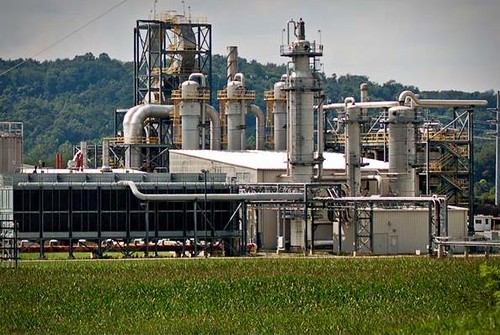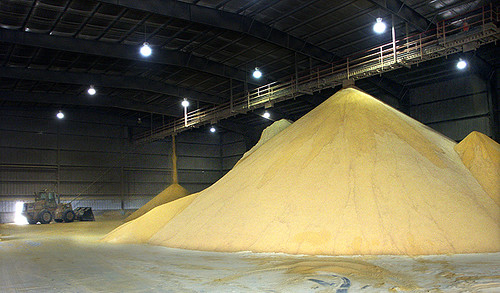
Ethanol, primarily derived from corn, supplies about 10 percent of US motor fuel needs. A new study from ICF which was released today, titled “A Life-Cycle Analysis of the Greenhouse Gas Emissions of Corn-Based Ethanol,” finds that greenhouse gas (GHG) emissions associated with corn-based ethanol in the United States are about 43 percent lower than gasoline when measured on an energy equivalent basis. This is comparable to reducing GHG emissions in the U.S. transportation sector by as much as 35.5 million metric tons per year.
Ethanol production has changed significantly over the past ten years. U.S. production has ramped up from 3.9 to 14.8 billion gallons per year between 2005 and 2015. As demand for corn ethanol has increased, corn production in the US expanded from 11.8 billion bushels in 2004 to 13.6 billion bushels in 2015 (NASS).
Unlike earlier studies of ethanol’s GHG benefits, which had to rely on projections of future ethanol production systems and expected impacts on the farm sector, this study was able to review how the industry and farm sectors have performed over the past decade to assess the current GHG profile of corn-based ethanol.
Earlier studies of ethanol’s GHG balance projected the effects of allocating billions of bushels of corn to ethanol production on supplies of corn and other commodities going to domestic and world food and feed markets. Those studies expected that farmers in the U.S. and other regions would respond to higher corn prices by bringing new lands into corn production. Bringing new land into commodity production typically results in increased GHG emissions—and those emissions can be large if the former land use was native grassland, wetland, or forest. However, what actually occurred in the US and around the world is more complex.

Increased use of corn to produce ethanol in the US did have a positive price effect on corn. As a result, within the US and abroad, idled croplands were brought into production; cropland already in production was managed more intensively; and by-products of corn ethanol production were used more efficiently as animal feed. Around the world, producers increased their use of double cropping.
The ICF report draws on those new data, including the analysis in Bruce Babcock and Zabid Iqbal’s publication “Using Recent Land Use Changes to Validate Land Use Change Models”. Babcock and Iqbal’s study confirmed that the primary land-use change response by the world’s farmers to increased demand for corn during the period 2004-2012 was to increase double cropping, reduce un-harvested planted area, reduce fallow land, and reduce temporary pasture in order to expand production. Moreover, the use of distillers dried grains and solubles (or DDGS) became a preferred substitute for corn grain, thereby muting the increased demand.
Those types of production gains are emblematic of innovation in modern agriculture. In 1961, it took 3.38 billion acres of cropland to feed the world’s population of 3.5 billion people. Over the next fifty years, the world’s population doubled to seven billion people, while cultivated land increased by only 12 percent to 3.78 billion acres. Productivity gains driven by improvements in technology have allowed farmers to get more output from existing resources, and thereby to keep pace with the growing demands an increasing global population puts on agriculture for food, fiber, and energy products.
In addition to the gains from reduced levels of land conversion, the ICF report shows that the reductions in GHG emissions from corn ethanol are continually driven by a variety of improvements in efficiency, from the corn field to the ethanol refinery. On-farm conservation practices, such as reduced tillage and nitrogen management, improved the GHG balance of growing corn for ethanol. Production yields, measured in gallons of ethanol per bushel of corn, have increased by 3.4 percent between 2006 and 2014.
Ethanol plants have also improved process efficiencies and can now produce biofuels that generate double the lifecycle GHG reductions estimated earlier, and there are opportunities to improve performance even more. New enzymes and yeast strains have increased process efficiencies in starch conversion and fermentation. Those process upgrades have become drivers for a decreasing GHG-intensity of corn ethanol production. Improved technologies such as combined heat and power, and using landfill gas for energy offer continued areas for improved efficiencies. New co-products, such as corn-oil biodiesel and DDGS have helped reduce GHG lifecycle emissions.
The report concludes that the GHG profile of corn ethanol is on track to be almost 50 percent lower than gasoline in 2022 if current trends in corn yields, process fuel switching, and improvements in trucking fuel efficiency continue.
One of the ICF report’s important findings is that there is a large potential for additional gains in ethanol’s GHG efficiency. The study examined the potential GHG benefits of additional on-farm conservation practices and efficiency improvements, such as the practices outlined in USDA’s Building Blocks for Climate Smart Agriculture and Forestry strategy. When these practices and plant efficiency improvements are universally adopted, the GHG benefits of corn ethanol are even more pronounced over gasoline—potentially rising to 76 percent gain in GHG benefits.
Continuing these trends is good news for the transportation sector—and the agriculture sector—when it comes to reducing GHG emissions.




